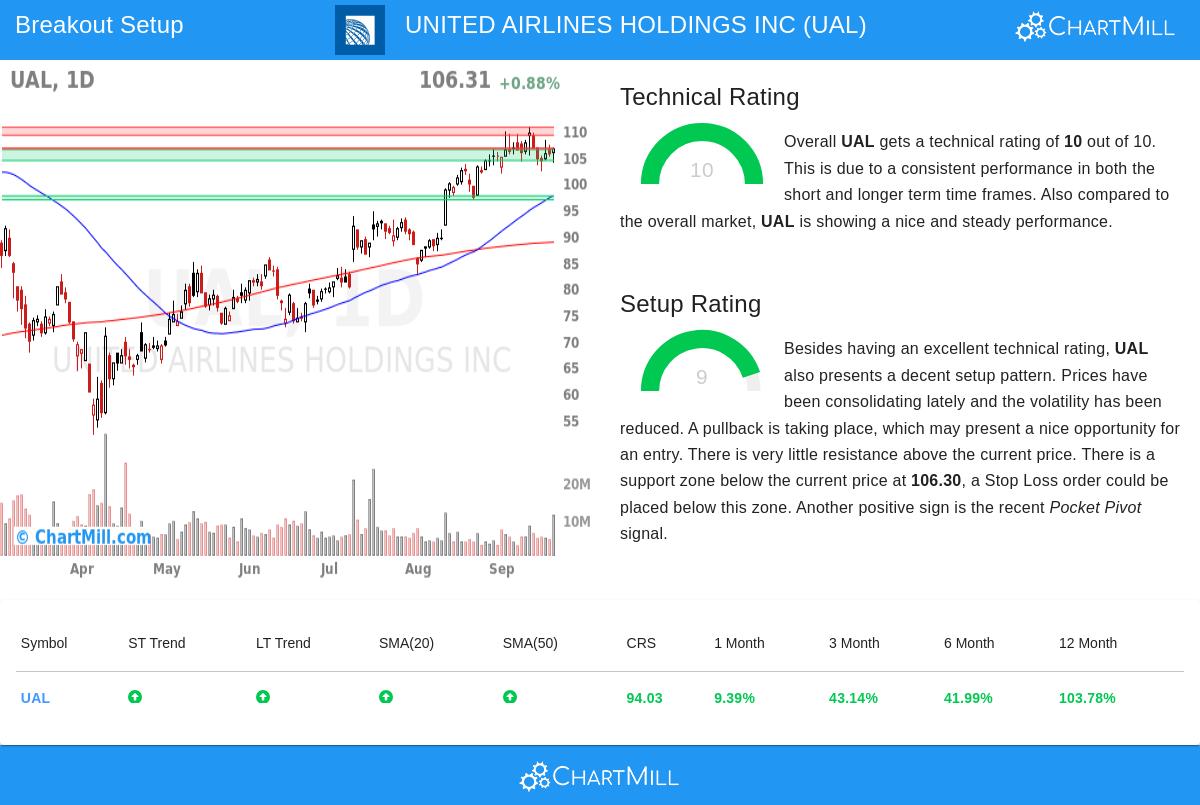United Airlines Holdings Inc (NASDAQ:UAL) Presents a High-Probability Technical Breakout Setup
Technical analysis investors often look for stocks showing both good momentum and consolidation patterns that indicate possible breakouts. One way to find these chances uses the ChartMill Technical Rating, which measures a stock’s general technical condition, and the ChartMill Setup Quality Rating, which checks for a good consolidation pattern. Stocks with high scores in both measures are seen as top choices for breakout methods, as they mix clear upward movements with times of price steadiness that frequently come before big moves.

UNITED AIRLINES HOLDINGS INC (NASDAQ:UAL) now offers a strong case for technical investors, receiving a top Technical Rating of 10 along with a high Setup Rating of 9. This pairing means the stock has both good basic health and a noticeable consolidation pattern, making it worth a detailed look for those using breakout methods.
Technical Condition and Momentum
The Technical Rating of 10 shows very good technical condition, which is important for breakout setups because it verifies the stock is in a clear uptrend and not just seeing short-term changes. United Airlines shows several good technical features:
- Both long-term and short-term trends are good, showing steady buying interest across various periods
- The stock does better than 94% of all stocks in yearly performance, showing notable relative condition
- It trades above all important moving averages (20-day, 50-day, 100-day, and 200-day), with each average moving upward
- The stock is in the higher part of its 52-week range, although it is a little behind the wider market’s new highs
These points together form a base of technical condition that breakout traders want, as stocks with good momentum often keep moving upward after consolidation times.
Setup Condition and Consolidation Pattern
The Setup Rating of 9 shows very good consolidation features, which is needed for finding the best entry points while controlling risk. United Airlines displays several features of a high-condition setup:
- Lower changes while prices consolidate between $97.52 and $110.66 over the last month
- A clear support area between $104.20 and $106.30 gives a sensible place for stop-loss orders
- Very little resistance is found above current price levels, meaning space for upward movement
- A recent Pocket Pivot signal shows institutional buying, adding confirmation to the setup
This consolidation pattern lets traders set clear risk limits while getting ready for a possible breakout above the $106.52 resistance level noted in the technical analysis report.
Risk Points and Trade Plan
While the technical view seems strong, several risk points need thought. The suggested stop loss at $104.19 means a somewhat close 2.19% risk per trade, which some traders may see as too bold given the stock’s average true range of 3.47 points. The nearness of the suggested entry to current price levels needs watchful checking for real breakout confirmation instead of early entry.
Traders should also think about the airline industry’s reaction to economic situations and fuel prices, which might affect the technical pattern. The present good market situation, with both short-term and long-term S&P 500 trends good, gives a supporting background, but industry-specific risks stay.
Finding Other Chances
For investors wanting to look for other technical breakout chances, more choices can be found using the Technical Breakout Setups screen, which often finds stocks mixing strong technical ratings with high-condition setup patterns.
Disclaimer: This analysis is for information only and does not make investment advice, a suggestion to buy, sell, or hold any security, or a offer to join any trading method. Past results do not show future outcomes. Investors should do their own research and talk with a qualified financial advisor before making investment choices.


